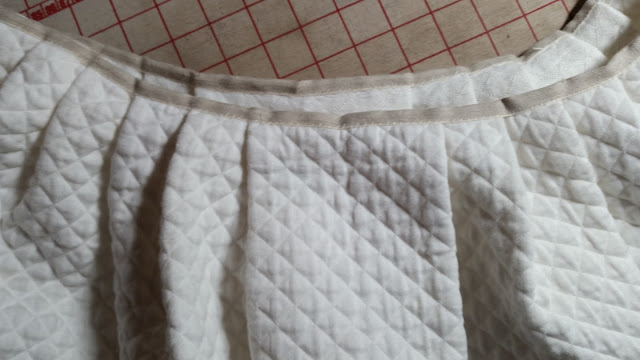I decided to upgrade the English gown in my previous post. I have several "plain" 18th century garments so I decided to make this one a little fancier. I needed something to wear to the SAR Patriot's Ball and we wanted to go in period attire. I simply didn't have time to do my silk gown that I have planned. This gown, while fancied up a bit, would still not be considered to be a ball gown. Multicolored cotton chintz was expensive in the day but it was still very much for day wear. This might have been more appropriate for a daytime country dance.
This gown is made from the J.P. Ryan Robe L'Anglaise (English Gown) pattern. The petticoat is made using
this tutorial which is my standard petticoat method.
I decided to add boning to the center back which was an optional thing in the pattern. I think it helps the back to lie more smoothly. I just ripped out a little of the stitching that secured the lining to the bodice, ran running stitches in the lining catching the seam allowance to make the boning channels and slipped in two 18 inch pieces of steel boning. Then I stitched the neckline back up.
As far as the upgrades go--First I added ruched trim around the neckline. I cut strips 1 3/4 inches wide with a rotary cutter then trimmed them with pinking shears. I decided to do the gathering and attaching in one step. Basically I did this by tacking down the end, taking 3 running stitches on the trim alone, pulling them tight then taking a back stitch through the trim and bodice to anchor it. I did this around the neck. I didn't know how much trim I would need so I just seamed it together as I went along.
Next I added sleeve ruffles. I used the Mill Farm pattern for embroidered sleeve flounces and I just cut them with pinking shears, stacked them, gathered and stitched them in the sleeves. I covered the raw edges with cotton twill tape. I added bows out of silk ribbon and temporarily basted in some removable lace flounces I had made from antique lace to dress it up a bit.
I decided to wear the gown as a polonaise so I made fabric covered buttons in period using bone button forms. I found a perfect motif in the fabric print to use as the focal point on the buttons, cut circles twice the diameter plus 5 mm and ran gathering stitches around the circle pulling it tight to cover. You can see the front and back of the buttons below. These were stitched to the side back seams. Silk ribbon loops were stitched inside which are looped over the buttons to drape the skirt. It can be worn up or left down.



Lastly, I made a matching petticoat. Typically I use 60 inch wide fabric and cut two lengths for a petticoat. This allows me to put the pocket slits in the side seams. This fabric was 42 inches wide however so I had to cut three lengths and cut the fabric for the pocket slits. I rolled the hem on the pocket slits and made thread bars at the bottom of the slit to keep it from splitting. I made a 4 inch box pleat in the center front with 1/2 inch pleats going around to a 4 inch inverted box pleat at center back. The petticoat is bound with 1 inch linen tape whip stitched on the inside and the outside.
I decided to make a nice pearl bracelet to wear since I was going to be dressed up.
I made a little hair ornament with silk ribbon and small ostrich feathers which I pinned in my wig. The gown was worn over the matching petticoat, a medium weight linen petticoat, traditional linen 18th century shift, J.P. Ryan strapless stays, silk clocked stockings and white Dunmore shoes by the American Duchess. I also pinned a silk ribbon bow to the neckline. The wig is The Duchess by The Historical Hairdresser and the jewelry, which includes the bracelet, a lover's eye pendant and pearl and crystal drop earrings were made by yours truly.



























